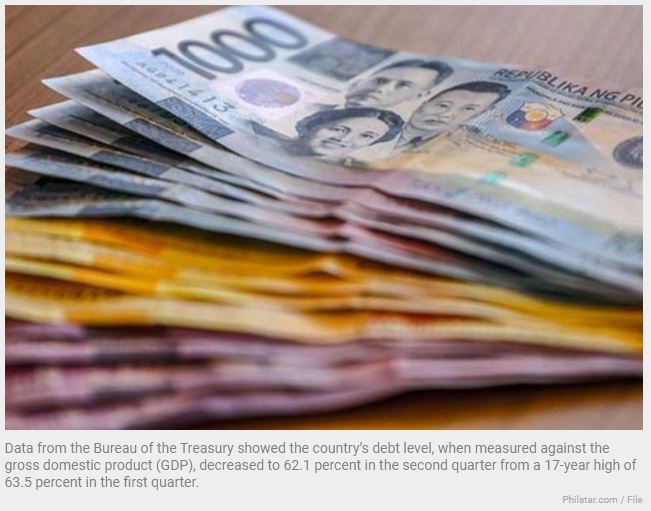Philippines: Debt-to-GDP ratio declines to 62% in H1
MANILA, Philippines — The share of national debt to the country’s output declined to 62.1 percent in the second quarter, but the downward trend may not be sustained if the government does not ramp up its revenue generation.
Data from the Bureau of the Treasury showed the country’s debt level, when measured against the gross domestic product (GDP), decreased to 62.1 percent in the second quarter from a 17-year high of 63.5 percent in the first quarter.
Domestic debt as a share of GDP went down to 42.6 percent, while the proportion of foreign obligations increased to 19.5 percent.
While the decline in debt-to-GDP ratio is a welcome development, economists told The STAR that the government faces a myriad of challenges to further bring the ratio down.
ING Bank senior economist Nicholas Mapa said the government must prioritize consolidation as this may shield the country from a potential credit downgrade.
The current debt-to-GDP ratio remains above the internationally accepted threshold of 60 percent, which puts the Philippines at a vulnerable spot in terms of its capacity to pay off its financial obligations.
“We will have to see if this trend can be sustained as authorities have voiced preference for spending without fresh taxes,” Mapa said.
“It might be hard if the government pushes through with aggressive spending plans. Something’s got to give,” he said.
The economic team, led by Finance chief Benjamin Diokno, has been firm in its stand to not slap taxes that may hurt more Filipinos amid the still ongoing pandemic. The government, instead, is banking on strong economic growth to boost revenues.
For this year, the government targets to further bring down the debt-to-GDP ratio to 61.8 percent.
Union Bank of the Philippines chief economist Ruben Carlo Asuncion said such a target is achievable provided that robust economic growth would continue.
But Asuncion warned that there are challenges ahead and the government has its hands already full.
“We have to note the challenges in the second half of the year, such as recession headwinds from the US and other advanced countries in the medium term. We also have to mention the still elevated domestic inflation that I think already impacted GDP growth in the second quarter,” Asuncion said, adding that “geopolitical risks still abound via the Ukraine-Russia conflict and US-China-Taiwan row. These are critical events to monitor.”
Rizal Commercial Banking Corp. chief economist Michael Ricafort, for his part, argued that higher inflation and interest rates could be a drag on economic growth and could slow down the improvement in the debt-to-GDP ratio.
Ricafort reiterated that intensified tax collections, new tax rates, and more disciplined government spending are necessary to sustain the improvement in the debt-to-GDP ratio.
But even if the government eventually decides on additional taxes, Asuncion maintained that implementation of new taxes would take time.
“That’s why I subscribe to a debt-to-GDP ratio still rising further, probably until 2024 before it goes down by 2025 or 2026,” he said.
From a target of 61.8 percent this year, the government aims to bring down the debt-to-GDP ratio to 61.3 percent in 2023. By 2024, the ratio is seen at 60.6 percent.
This will reach the internationally accepted threshold by 2025 at 59.3 percent. Further declines are seen by 2026 and 2027 at 57.7 percent.
Once the term of Marcos ends in 2028, the debt-to-GDP ratio is targeted to be at 52.5 percent.
The country’s debt stock is currently at a record P12.79 trillion as of end-June.
This year, the government planned to borrow P2.47 trillion, of which P1.91 trillion would come from domestic sources while the remaining P560.58 billion would be from external sources.
This is four percent lower than the P2.58 trillion total borrowings for the whole of 2021.
Source: https://www.philstar.com/business/2022/08/10/2201481/debt-gdp-ratio-declines-62-h1


 Thailand
Thailand




